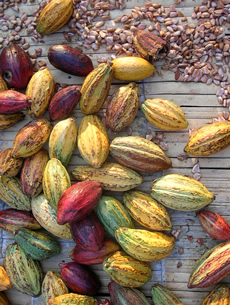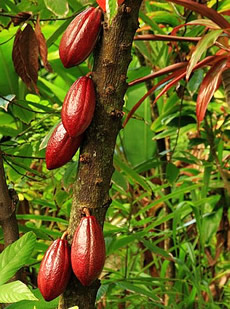World History
Called kakaw in the language of the ancient Maya, associated with the merchant deity El Chuaj, or “black scorpion,†cacao (processed into cocoa), from which chocolate is derived, was widely produced across large parts of lowland Mesoamerica and Central America, the regions to which it was indigenous. Like coffee, the seed of a small tree, cacao was one of the region’s most important trade items, with cacao beans often used as a form of currency, as among the Aztecs.
Cultivated since at least 600 b.c.e., cacao was one of the chief items of trade and export among some Maya polities, such as the Early Classic Pacific Coast city-state of Balberta. Its consumption limited to the elite, with strict taboos against commoners’ production and use, cacao was mixed with foods and spices such as chili, maize flour, and cinnamon to make various chocolate drinks.
The conquest of Mexico and conquest of Central America transformed the production and consumption of cacao in important ways. No longer restricted exclusively to the elite, cacao consumption soared among most all social groups—Indian, Spanish, mestizo, and, to a lesser extent, Africans.
Spaniards also changed the traditional recipe, often dispensing with maize flour and sweetening it with sugar and vanilla. By the mature colonial period, cacao had become a most popular nonalcoholic beverage in Spanish and colonial Mexico.
Cacao also became an important element in Spain’s mercantile economy, along with other tropical export commodities such as sugar, tobacco, indigo, and cochineal. As a result of increased demand, both within the colonies and overseas, cacao production increased dramatically.
Cacao plantations soon emerged across Mesoamerica and the circum-Caribbean, including Venezuela, along the Pacific coast from Guatemala to Ecuador and Peru, and southeast to the settled coastal areas of Brazil.
 Guatemala witnessed a cacao boom in the decades after the initial conquests that declined along with Indian populations after 1570. Cacao, along with maize, beans, and other staple crops, became one of the stock items that encomienda Indians were required to pay in tribute to their encomendero masters.
Guatemala witnessed a cacao boom in the decades after the initial conquests that declined along with Indian populations after 1570. Cacao, along with maize, beans, and other staple crops, became one of the stock items that encomienda Indians were required to pay in tribute to their encomendero masters.
Throughout the colonial period, as the European market for American tropical export commodities grew, cacao, transformed with sugar into various types of chocolate, became very popular among both the elite and Europe’s burgeoning industrial working classes.
This was part and parcel of a consumption revolution within Europe in consequence of overseas colonization and the Industrial Revolution, as urban working classes in particular consumed increasingly prodigious quantities of coffee, tea, tobacco, sugar, and chocolate.
Cacao, like coffee, also became increasingly important across large parts of Africa, transforming local economies and local consumption patterns. An important element of the Columbian exchange, cacao, along with maize, manioc, potatoes, and other staple crops, represented yet another of the Americas’ gifts to the world.
- Columbian Exchange
Columbian Exchange Two ecological systems, evolved for thousands of years in near total isolation from each other, suddenly thrust together, flooding each side with the organisms of the other over the course of nearly five centuries—this is the...
- Obrajes In Colonial Latin America
Obrajes in Colonial Latin AmericaObrajes (roughly, workshops) were key enterprises in the developing economies of Spain’s American colonies, principally as sites where wool, cotton, and other fibers were carded, spun, and woven into textiles. While...
- Viceroyalty Of Peru
The largest and second most important political jurisdiction in Spain’s American empire after the Viceroyalty of New Spain, the Viceroyalty of Peru came into being in 1542 during the civil wars that wracked the Andes during the conquest of Peru....
- Silver In The Americas
The discovery of massive deposits of silver in New Spain and Peru from the mid-16th century set in motion a chain of events that reverberated across the globe. Large-scale silver production in Spanish America not only transformed local, regional, and...
- Sugarcane Plantations In The Americas
Sugarcane Plantation The histories of African slavery and sugar production in the Americas are inextricably bound together. The plantation economies of the Caribbean and Brazil, which together received approximately 80 percent of the estimated 10 million...
World History
Cacao
 |
| Cacao Plant |
Cultivated since at least 600 b.c.e., cacao was one of the chief items of trade and export among some Maya polities, such as the Early Classic Pacific Coast city-state of Balberta. Its consumption limited to the elite, with strict taboos against commoners’ production and use, cacao was mixed with foods and spices such as chili, maize flour, and cinnamon to make various chocolate drinks.
The conquest of Mexico and conquest of Central America transformed the production and consumption of cacao in important ways. No longer restricted exclusively to the elite, cacao consumption soared among most all social groups—Indian, Spanish, mestizo, and, to a lesser extent, Africans.
Spaniards also changed the traditional recipe, often dispensing with maize flour and sweetening it with sugar and vanilla. By the mature colonial period, cacao had become a most popular nonalcoholic beverage in Spanish and colonial Mexico.
  |   |
Cacao also became an important element in Spain’s mercantile economy, along with other tropical export commodities such as sugar, tobacco, indigo, and cochineal. As a result of increased demand, both within the colonies and overseas, cacao production increased dramatically.
Cacao plantations soon emerged across Mesoamerica and the circum-Caribbean, including Venezuela, along the Pacific coast from Guatemala to Ecuador and Peru, and southeast to the settled coastal areas of Brazil.

Throughout the colonial period, as the European market for American tropical export commodities grew, cacao, transformed with sugar into various types of chocolate, became very popular among both the elite and Europe’s burgeoning industrial working classes.
This was part and parcel of a consumption revolution within Europe in consequence of overseas colonization and the Industrial Revolution, as urban working classes in particular consumed increasingly prodigious quantities of coffee, tea, tobacco, sugar, and chocolate.
Cacao, like coffee, also became increasingly important across large parts of Africa, transforming local economies and local consumption patterns. An important element of the Columbian exchange, cacao, along with maize, manioc, potatoes, and other staple crops, represented yet another of the Americas’ gifts to the world.
- Columbian Exchange
Columbian Exchange Two ecological systems, evolved for thousands of years in near total isolation from each other, suddenly thrust together, flooding each side with the organisms of the other over the course of nearly five centuries—this is the...
- Obrajes In Colonial Latin America
Obrajes in Colonial Latin AmericaObrajes (roughly, workshops) were key enterprises in the developing economies of Spain’s American colonies, principally as sites where wool, cotton, and other fibers were carded, spun, and woven into textiles. While...
- Viceroyalty Of Peru
The largest and second most important political jurisdiction in Spain’s American empire after the Viceroyalty of New Spain, the Viceroyalty of Peru came into being in 1542 during the civil wars that wracked the Andes during the conquest of Peru....
- Silver In The Americas
The discovery of massive deposits of silver in New Spain and Peru from the mid-16th century set in motion a chain of events that reverberated across the globe. Large-scale silver production in Spanish America not only transformed local, regional, and...
- Sugarcane Plantations In The Americas
Sugarcane Plantation The histories of African slavery and sugar production in the Americas are inextricably bound together. The plantation economies of the Caribbean and Brazil, which together received approximately 80 percent of the estimated 10 million...
